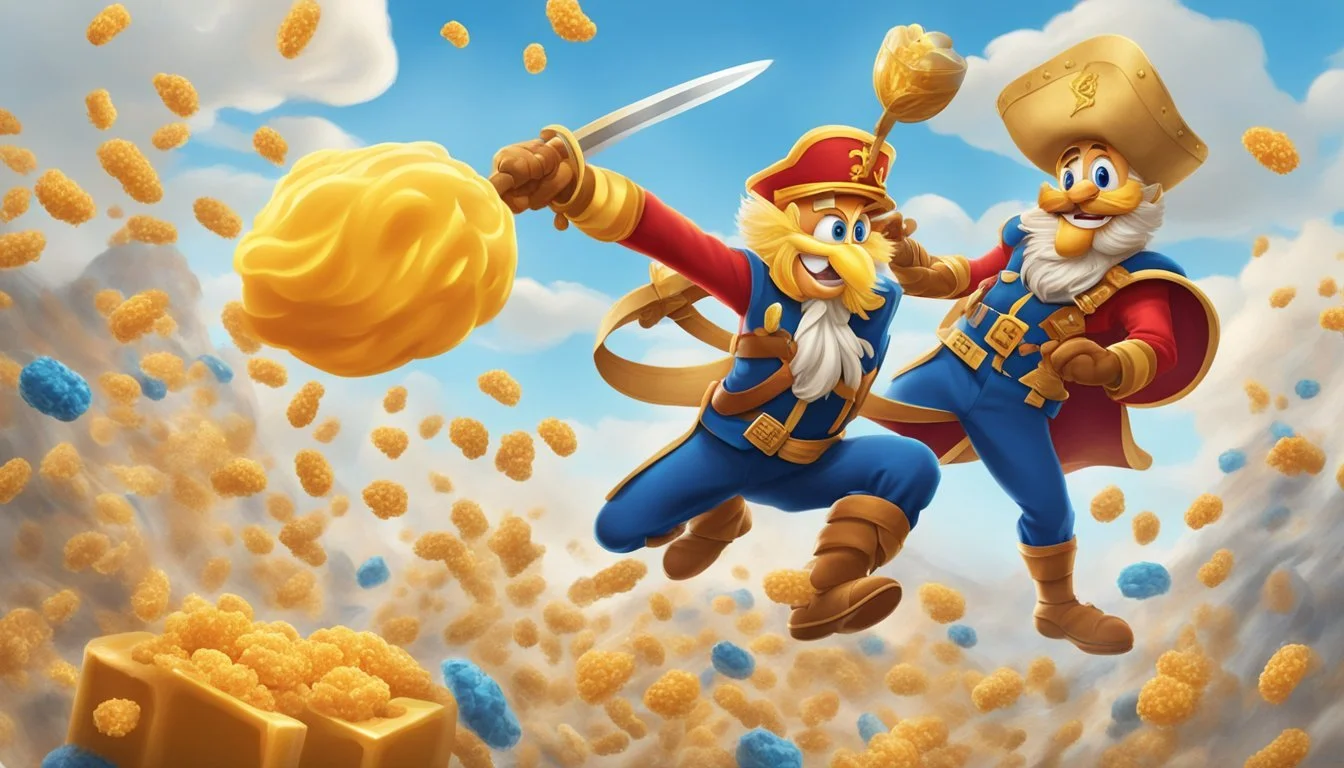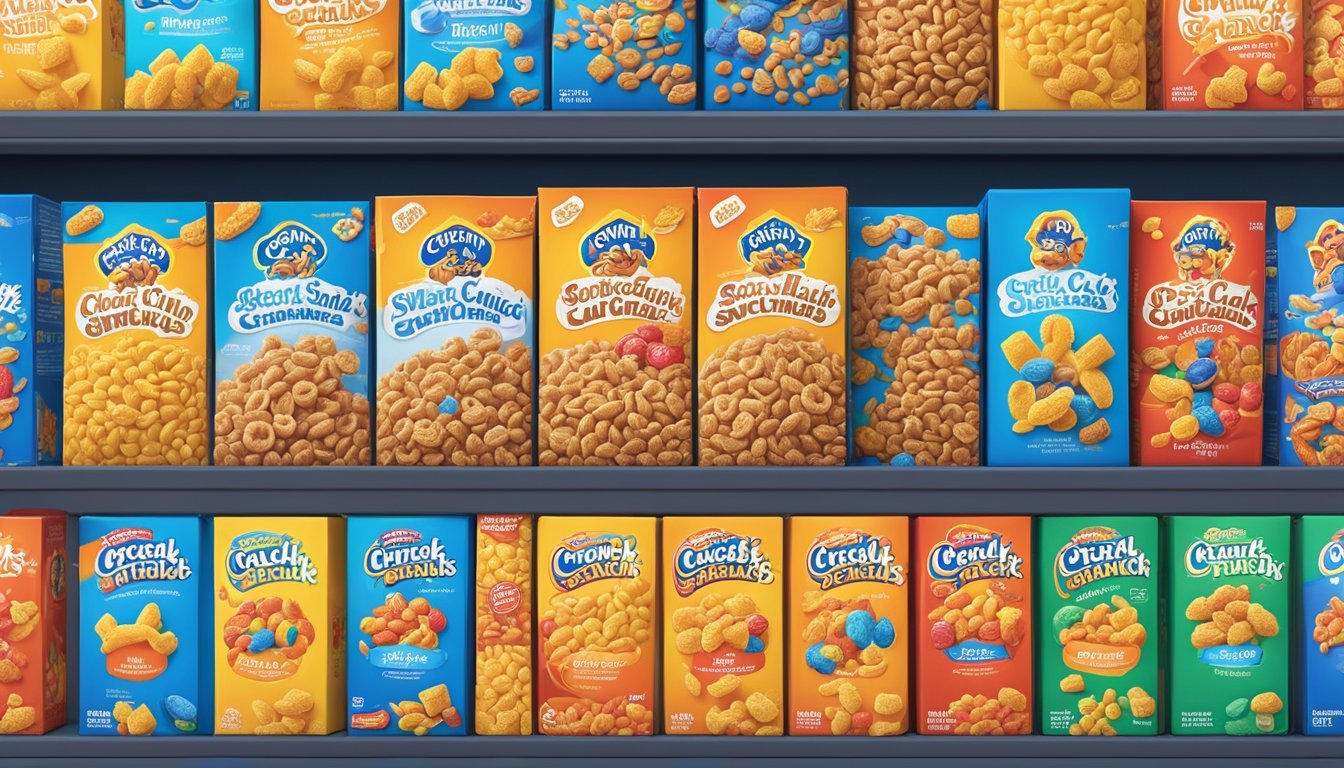Cap'n Crunch vs Honey Smacks
Nutritional Comparison and Taste Test
This Article is Part of Our Breakfast Cereal Guide with Details on Cap'n Crunch Nutrition and Honey Smacks Nutrition
When choosing between Cap'n Crunch and Honey Smacks, it helps to weigh their nutritional content and taste profiles. Cap'n Crunch offers significantly higher amounts of Iron and Folate, making it a choice for those needing a nutritional boost in these areas. On the other hand, Honey Smacks provides higher levels of essential vitamins like Vitamin B12, Vitamin A, and Vitamin C.
Cap'n Crunch has a distinct crunchy texture and the iconic sweet flavor beloved by many. Each serving contains 12 grams of complex carbohydrates, providing a steady source of energy for the morning. Honey Smacks, while slightly lower in iron, offers a sweeter taste with noticeable honey undertones and contains just 9 grams of complex carbohydrates.
Both cereals cater to different dietary needs and taste preferences. For those looking to boost their micronutrient intake, Cap'n Crunch is the better option. Honey Smacks appeals to those desiring a cereal higher in certain vitamins and with a sweet honeyed flavor.
Historical Overview
Cap'n Crunch cereal and Kellogg's Honey Smacks have distinct origins that reflect their evolution and impact on the breakfast cereal market. These cereals have carved out unique niches, driven by marketing strategies and consumer preferences.
Origins of Cap'n Crunch Cereal
Cap'n Crunch cereal launched in 1963 by Quaker Oats. It was developed by Pamela Low, who was inspired by a recipe for brown sugar and butter served over rice. The flavor profile, featuring a signature sweetness, quickly appealed to children.
Marketing played a significant role in Cap’n Crunch's popularity. The character of Cap'n Horatio Magellan Crunch was created, becoming a staple in advertising campaigns. Ads often featured animated adventures that aired during popular Saturday morning cartoon time slots.
This strategic placement helped Cap’n Crunch capture the breakfast market among young audiences. The cereal's appeal was further cemented by its unique texture that stayed crunchy in milk.
Rise of Kellogg's Honey Smacks
Kellogg's Honey Smacks, originally known as Sugar Smacks, debuted in 1953. The cereal was marketed for its sweet taste, derived from honey and sugar. This helped establish it as a favorite among children.
Its advertising campaigns often included mascots like Dig'em the Frog, which contributed to its recognition. Like Cap’n Crunch, Honey Smacks also utilized Saturday morning ads to reach its target audience.
The cereal underwent rebranding over the years, changing its name from Sugar Smacks to Honey Smacks in response to growing health concerns. Despite changes, it retained its core flavor and continued to boast high sugar content, which remains a defining characteristic.
Nutritional Comparison
Cap'n Crunch and Honey Smacks offer distinct nutritional profiles, each catering to different dietary needs and preferences. This section will analyze key aspects such as caloric content, sugar and fat, and vitamins and minerals.
Caloric Content Analysis
Both cereals provide a modest number of calories per serving. Cap'n Crunch offers 120 calories per 0.75 cup serving, while Honey Smacks comes in slightly lower with 110 calories for the same serving size.
These values make both cereals relatively low-calorie options for breakfast, suitable for those monitoring their caloric intake. The difference of 10 calories is minimal, so consumers looking for a slight reduction might lean toward Honey Smacks.
Sugar and Fat Content
Sugar content is an area of interest for many consumers. Cap'n Crunch contains a substantial amount of sugar, known for its sweet flavor. Detailed data shows 12 grams of sugar per 0.75 cup serving.
Honey Smacks, however, have previously been noted for their particularly high sugar content. They contain about 15 grams per serving. This makes Honey Smacks a significantly sweeter option, which might appeal to those with a sweet tooth.
Regarding fat content, Cap'n Crunch has 2 grams of fat per serving, whereas Honey Smacks is lower in fat with 1 gram per serving. This lower fat content might make Honey Smacks a more appealing choice for those looking to reduce their fat consumption.
Vitamins and Minerals Profile
The vitamins and minerals present in each cereal vary, offering different nutritional benefits. Cap'n Crunch is particularly rich in Folate, Iron, and Zinc. It provides 19.42mg of Iron per serving, which is notably higher compared to Honey Smacks' 1.5mg.
Honey Smacks, on the other hand, are higher in Vitamin B12, Vitamin A RAE, Manganese, Selenium, Vitamin D, and Vitamin C. These vitamins and minerals are essential for various bodily functions and can be more advantageous depending on dietary needs.
For instance, Honey Smacks have a significantly lower Sodium content at 70mg per serving, compared to Cap'n Crunch's 220mg. This can be a critical factor for individuals monitoring their salt intake.
Both cereals offer unique nutritional benefits, catering to different health priorities and taste preferences.
Taste and Texture Experience
Cap'n Crunch and Honey Smacks offer distinct flavor experiences and textural qualities that cater to different preferences. Below, the specific flavor profiles and textural experiences of each cereal are explored.
Flavor Profiles
Cap'n Crunch features a rich, sweet corn flavor with hints of vanilla. This cereal is known for its robust sweetness, making it a favorite among those who enjoy sugary cereals. The sweetness can be intense, and the use of corn as a base provides a unique taste that stands out from other cereals.
Honey Smacks delivers a sweet honey flavor with a toasted, nutty undertone. This combination creates a balanced sweetness that is both satisfying and rich. The honey taste is prominent, offering a natural sweetness that pairs well with the cereal's toasty background, making it a delightful option for breakfast.
Texture and Consistency
Cap'n Crunch is famous for its distinctive crunch that retains its crispiness even when soaked in milk. The texture is firm, preventing it from becoming soggy too quickly. This consistency is a key attribute for those who prefer a cereal that remains crunchy throughout their meal.
Honey Smacks has a lighter, puffed rice texture. This cereal tends to soften faster in milk, creating a different eating experience. The initial crispiness gives way to a chewier consistency, providing a contrasting texture that some may find appealing. The lighter construction of Honey Smacks creates a variety of textures from the first bite to the last.
Consumer Perception and Branding
Consumer perception and branding play vital roles in how Cap'n Crunch and Honey Smacks maintain and grow their market presence. Both brands leverage distinct marketing strategies to appeal to their target demographics, focusing on unique selling points and memorable advertising campaigns.
Market Positioning
Cap'n Crunch, produced by Quaker Oats, has built its brand around its unique flavor and high sugar content. Reminiscent of a brown sugar and butter recipe, it appeals mainly to children and nostalgic adults. This cereal uses bold, colorful packaging featuring its iconic mascot, Cap'n Crunch, adding to its appeal on supermarket shelves.
By contrast, Kellogg’s Honey Smacks positions itself as a somewhat healthier sugary cereal. It emphasizes its high vitamin content, including Vitamin B12 and Vitamin A, and markets itself as a tasty yet nutrient-rich option. The packaging is also vibrant and features a frog mascot, making it easily recognizable.
Advertising Campaigns
Cap'n Crunch’s advertising has historically focused on its fun, playful image. Commercials often feature the Cap'n in adventurous, cartoon-like scenarios, appealing strongly to a younger audience. This consistent character presence helps foster brand loyalty and recall.
Honey Smacks uses a combination of health-focused messaging and fun imagery. While the frog mascot draws in a younger crowd, the cereal's fortified vitamins are highlighted to attract health-conscious parents. Past campaigns have also focused on its crunchy texture and sweet taste, keeping the product appealing across generations.
Both brands utilize social media and online platforms to engage with their audience, employing interactive content and promotions to maintain consumer interest and drive sales.
Dietary Considerations
Dietary preferences and allergen information are critical when comparing Cap'n Crunch and Honey Smacks. Both cereals have unique nutritional profiles and potential allergens that should be considered.
Health-Conscious Choices
For those seeking a healthy diet, Cap'n Crunch and Honey Smacks differ significantly in terms of nutrients and additives.
Caloric Content: Cap'n Crunch contains 220 calories per serving, whereas Honey Smacks offers a slightly lower count.
Fat Content: Cap'n Crunch has 2 grams of fat per serving, compared to Honey Smacks, which contains 1 gram.
Sodium: Cap'n Crunch is higher in sodium, with 220 milligrams per serving, while Honey Smacks has just 70 milligrams.
Sugar: Honey Smacks is notably high in sugar, with 19.4 grams per serving, equating to nearly two donuts. Cap'n Crunch also contains added sugars, though in slightly lesser amounts.
Vitamins and Minerals: Cap'n Crunch excels in iron, providing 19.42 mg per serving, far surpassing Honey Smacks. However, Honey Smacks has higher levels of Vitamin B12, Vitamin A, and several other key vitamins.
Allergen Information
Allergen considerations are pivotal for those with food sensitivities or allergies.
Common Allergens: Both cereals may contain gluten, as they are often made with wheat-based ingredients. Additionally, they may have soy, milk, and nut traces due to packaging processes.
Ingredient Sensitivities: Cap'n Crunch may pose concerns for those sensitive to artificial colors and flavors, which are often used in its production.
Health Impact: For consumers needing to avoid high sugar content due to diabetes or other conditions, Honey Smacks’ high sugar levels are a significant consideration. On the other hand, those watching sodium intake might lean towards Honey Smacks.
By understanding these dietary considerations, consumers can make better choices aligned with their nutritional goals and allergy concerns.
Consumption Patterns
The dietary habits surrounding Cap’n Crunch and Honey Smacks underscore how versatile these cereals are in daily intake. Consumers often enjoy them both as a morning meal and as a midday or evening snack.
Cereal as Breakfast
Breakfast remains the most common time for consuming both Cap'n Crunch and Honey Smacks. Typically, a serving size of these cereals is around 1 cup, which is often paired with milk.
Cap'n Crunch is favored for its sweet, crunchy texture that appeals to those who enjoy a sugary start to their day. With 1 gram of protein and 2 grams of fat per serving, it provides a modest nutritional profile. Honey Smacks, containing 2 grams of protein and 1 gram of fat per serving, offers a slightly different nutritional balance.
A notable aspect is that Honey Smacks contain less sodium than Cap'n Crunch, which may be a consideration for those monitoring their sodium intake at breakfast.
Cereal as Snack
As a snack, both cereals serve an enjoyable, quick option for consumers. Their high sugar content makes them appealing for those seeking a sweet treat between meals.
Cap'n Crunch, with its 19.42 mg of Iron and high folate content, can be an iron-boosting option for a snack. It maintains its crunchiness and sweetness even when consumed dry, which enhances its appeal.
Honey Smacks, on the other hand, boast higher levels of Vitamin B12, Vitamin A, Vitamin C, and other nutrients. This makes it a preferable choice for those looking for a vitamin-rich snack option. Both cereals are often eaten in smaller portions when consumed as a snack, focusing more on taste and instant gratification.
Comparison with Other Cereals
Cap’n Crunch and Honey Smacks are popular sweetened cereals, but how do they compare with other options in the market? This section will explore both cereals' positioning relative to other well-known sweetened and non-sweetened cereals.
Cap'n Crunch vs Other Sweetened Cereals
Cap’n Crunch, produced by Quaker Oats, contains 120 calories per 0.75-cup serving. It also has 2 grams of fat and 220 milligrams of sodium.
Compared to Frosted Flakes and Cinnamon Toast Crunch, Cap’n Crunch is higher in sodium but on par calorie-wise.
Cereal Calories per Serving Fat per Serving Sodium per Serving Cap'n Crunch 120 2 grams 220 mg Frosted Flakes 130 0 grams 150 mg Cinnamon Toast Crunch 130 3 grams 180 mg
Cap’n Crunch boasts significantly higher iron content than many competitors. It has 13 times more iron than Kellogg's Honey Smacks and better folate coverage. Compared to Cocoa Puffs and Lucky Charms, which are also iron-rich, Cap’n Crunch holds its own. However, it has less fiber and protein than cereals like Frosted Mini-Wheats.
Honey Smacks in the Competitive Landscape
Honey Smacks, produced by Kellogg's, is another strong contender in the sweetened cereals category. It has 110 calories and 1 gram of fat per 0.75-cup serving. It contains a lower sodium level at 70 milligrams.
Cereal Calories per Serving Fat per Serving Sodium per Serving Honey Smacks 110 1 grams 70 mg Golden Crisp 100 0 grams 150 mg Fruity Pebbles 110 1 grams 140 mg
Honey Smacks is particularly high in Vitamin B12, Vitamin A RAE, and Vitamin C.
While Golden Crisp and Fruity Pebbles have comparable calorie counts, they differ in nutritional content. Honey Smacks has a higher vitamin profile and less sodium.
When compared to these cereals, Honey Smacks stands out in its vitamin content but has a similar sugar level to Froot Loops and Trix. This can make it a better choice for those focused on vitamins while still enjoying a sweet cereal.
Cereal Production and Ingredients
Cap'n Crunch and Honey Smacks utilize distinct ingredients and production techniques that appeal to different consumer tastes and nutritional preferences. The following sections detail how these cereals are made and what goes into their recipes.
Sourcing of Ingredients
Cap'n Crunch primarily uses corn and oats as its base ingredients. Cornmeal and oat flour form the bulk of the cereal, adding to its crunchy texture and providing essential nutrients like fiber and vitamins. Sugar is a significant component, giving Cap'n Crunch its signature sweetness. Additional ingredients include oils and flavorings to enhance taste.
Honey Smacks, on the other hand, feature wheat as the main ingredient, along with a notable quantity of honey, which not only sweetens the cereal but also offers a unique flavor profile. Rice is occasionally included to add crunch and texture. Both cereals are typically fortified with vitamins and minerals to boost their nutritional value.
Processing Techniques
Cap'n Crunch undergoes several stages of processing. The blend of cornmeal and oat flour is extruded to form the cereal's distinctive shape. Extrusion involves heating and molding the mixture under high pressure, which cooks the cereal and produces its crunchy texture. After extrusion, the pieces are coated with sugar and flavorings and then baked to achieve their final form.
Honey Smacks follow a different production technique. Wheat is puffed using high-pressure steam, which expands the grains and forms the light, airy texture characteristic of the cereal. Honey is applied post-puffing, allowing it to coat the cereal evenly. This process not only sweetens the cereal but also seals in its crispy texture.
Both cereals rely on meticulously controlled processes to ensure consistency and quality, highlighting the intricate balance of ingredients and techniques in cereal production.
Editorial Perspectives
Health experts and consumers provide valuable insights on the nutritional value and taste of both Cap'n Crunch and Honey Smacks. Their combined perspectives reveal significant points of comparison between these popular cereals.
Health Experts' Opinions
Health experts often examine cereals based on their nutritional content. Cap'n Crunch offers higher iron content, providing 19.42mg per serving compared to Honey Smacks' 1.5mg. This makes Cap'n Crunch a better choice for those needing more iron in their diets.
However, Honey Smacks has less sodium than Cap'n Crunch, which can be crucial for individuals monitoring their salt intake. Originally, Cap'n Crunch has 2 grams of fat per serving while Honey Smacks contains only one. The higher sugar content in both cereals has been a consistent topic of critique among nutritionists.
Consumer Reviews and Testimonials
Consumer feedback frequently highlights the taste and texture of these cereals. Many prefer Honey Smacks for its sturdy constitution and toasty finish, a flavor that evokes nostalgia and classic Saturday mornings spent eating cereal.
Cap'n Crunch is favored for its crunchy texture and delicious sweetness but is noted for being less appealing due to its tendency to scrape the roof of one's mouth. Testimonials often reflect the personal preferences of individuals, underscoring how subjective taste can be. Both cereals maintain a strong fan base, driven by their unique tastes and traditional flavor profiles.






